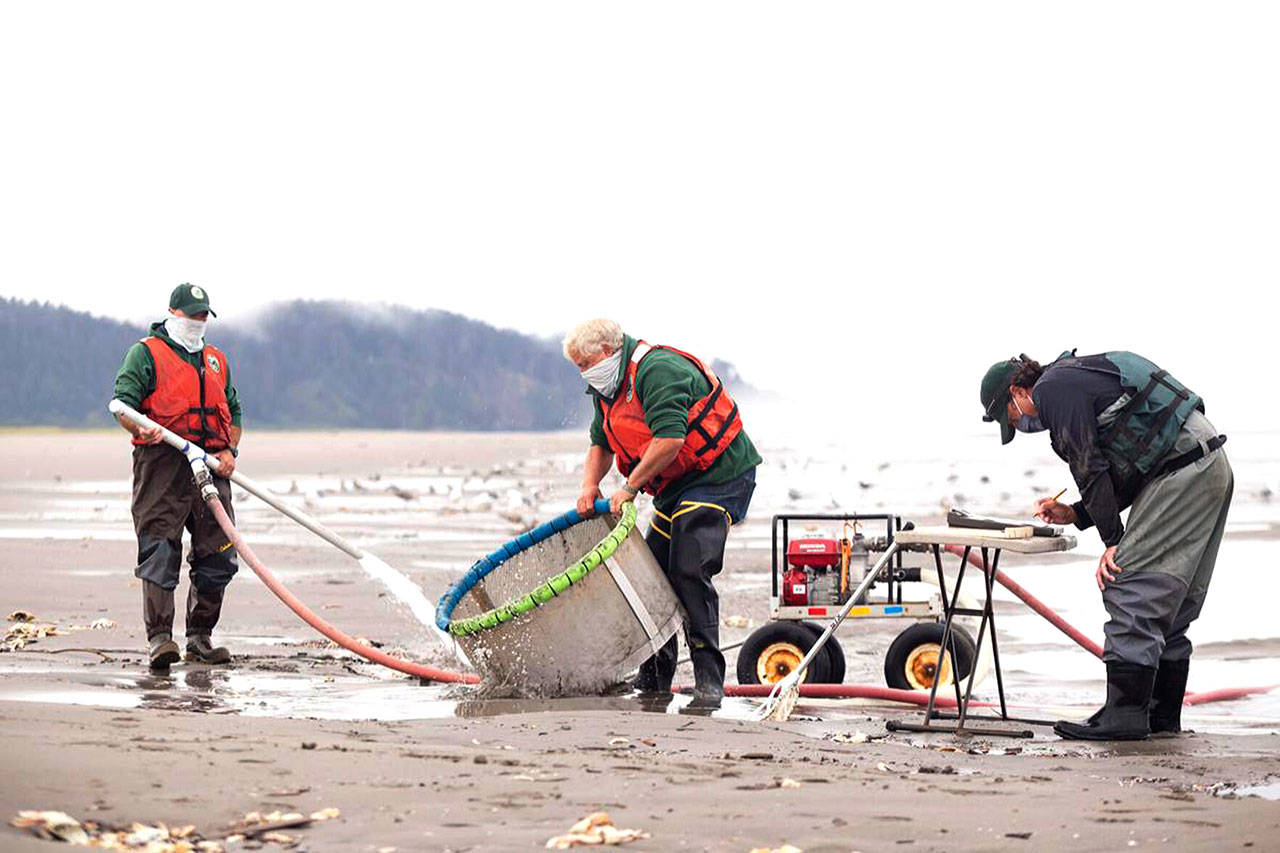LONG BEACH — The Washington coast razor clam population has climbed to a historic high, according to final stock assessment surveys conducted this week by the Washington Department of Fish and Wildlife. This includes a pronounced increase along the entire Long Beach Peninsula.
“We have a pretty strong population coastwide,” said WDFW Coastal Shellfish Manager Dan Ayres after conducting the survey with fellow technicians on Tuesday in Long Beach, one of their final preludes to the season.
“Long Beach is particularly strong in comparison to previous years. I’ve been around 40 years and I’ve never seen anything like it on Long Beach.”
The estimated total of harvestable clams coastwide is predicted to be double that of last year, among the highest in decades.
“The preliminary number is 26 million (of harvestable clams coastwide for the 2020-21 season) and last year was 13 million,” Ayres said.
“Last year, we had a [razor clam] population on Long Beach that was the highest recorded in 25 years. This year, even though we’re not quite done, looks like it’s going to be significantly higher, perhaps double, which is really good news all the way around. We’re seeing that populations are up on all the beaches.”
The current sample survey results have far exceeded Ayres’ expectations, particularly in Long Beach and in Copalis Beach in Grays Harbor County, largely driven by favorable ocean conditions and less pressure from diggers in recent months.
“We saw good survival from last year,” Ayres said. “We had some harvest last year but we didn’t take nearly what we expected to take because we didn’t get to those good tides in the spring. I anticipated some of that to be held over but razor clams have a population that live and die unrelated to harvest, and you just never know quite what you’re going to come back to. We could have come back to far fewer clams. But most of the clams seemed to survive and then we had some very good recruitment of small clams that grew up. There are clams all over the place. The north end (of the Long Beach Peninsula) is just phenomenal.”
The distribution of healthy, dense razor clam populations peninsula wide seems to be growing, Ayres said.
“Typically in Long Beach the northern third is strong and the rest is a little week, but now more than three quarters of the beach is really strong with the lower (southern) end a little on the light side, but it’s not bad. Clam diggers will discover that when they get out — if we get out. That’s the big question.”
Covid-19 hurdles?
There were no annual razor clam sestivals and fewer dig days this spring along the entire coast as a result of the
Covid-19 pandemic, which cancelled events and restricted mass gatherings to slow the spread of the virus.
The ongoing pandemic and domoic acid concerns remain as the biggest threats to derailing the upcoming 2020-2021 recreational razor clam season, which typically starts in the fall under normal circumstances.
“We’re carefully watching the domoic acid situation. There was an increase in domoic acid levels in razor clams on the Clatsop beaches and they are often similar to what we see up here. We collected clams this week and they’re headed to lab, so by the end of the week we’ll have some feel where we’re at,” Ayres said.
“We’re watching the levels of the diatoms that produce domoic acid in the water and they’re on the increase, so there could be problem there. But other than that it’s going to be about Covid-19 and how comfortable communities are having crowds. We have some upcoming meetings scheduled with local leaders, state legislators, the governor’s office and the health department.”
Surveys help set seasons
The survey on Tuesday was one of 58 conducted coast-wide this summer along Washington beaches to assess razor clam populations and set upcoming recreational seasons. Nearly half of the samples occur on the along the Long Beach Peninsula’s ample 28 miles of sand.
“We try to do one transect per mile,” Ayres said. Two teams involving three technicians each worked different tracts of Long Beach on Aug. 18. The teams used a pump-sampling method learned from management officials in Alaska and now the preferred method in Washington and Oregon. Pump sampling is more sensitive to catching juvenile clams that may have been missed in the past, providing a more accurate picture of the clam population in the area. The same method was used to assess razor clam populations to estimate how many clams were on each of the five management beaches on Washington’s outer coast, Ayres said.



